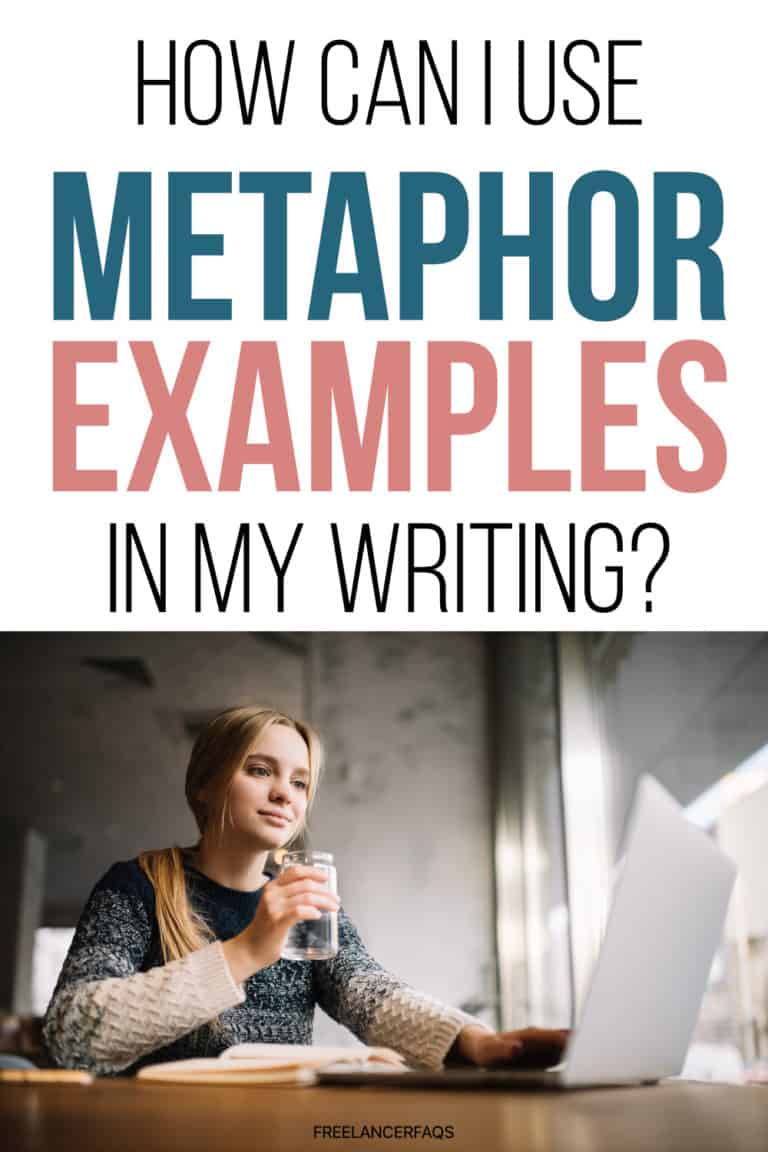Are you looking for a way to make your content stand out in a crowd?
Do you want your work to be head and shoulders above the rest?

Understanding how to do this is not rocket science.
You can do this by using metaphor examples when writing!
Metaphors make unfamiliar or complex ideas seem simple and relatable by comparing the known to the unknown.
Metaphors are so effective in communication that they have become ingrained in our everyday language, and they can be easily used in content writing.
But before you become a bull in a china shop when adding metaphors to your writing, let’s look at what they are and how you can use them:
First Thing First – What Are Metaphors?

Similes are like metaphors.
That one’s for all the word-nerds out there!
But, seriously, in order to understand what a metaphor is, it’s important to look at how they compare to similies.
Both make comparisons, but similes spell it out using the words “like” and “as”:
“I’m hungry as a horse.”
Pretty straightforward. I’m really hungry.
Metaphors, on the other hand, are a form of figurative language that compares two seemingly unrelated things without using these filler words.
It states that one thing is another thing in order to illustrate a more interesting comparison.
Have you ever called someone a couch potato? That’s a metaphor!
It’s comparing a human being to an inanimate vegetable to illustrate that someone is lazy.
Remember when Katy Perry said, “Baby, you’re a firework!”
She’s describing someone as being exciting by comparing them to a firework.
Did your workout feel like murder? Metaphor!
Metaphor examples can really make your words come to life in your writing, which is why you should definitely consider adding them to your content!
Why Do Metaphors Work in Content Writing?
With everyone and their dog searching for information on the internet, people are constantly bombarded with content!
To cut through the noise and stand out with quality content, use metaphors to provide engaging and creative information.
When well written, metaphors can create a vivid image for your readers and make your message more memorable.
Here are some ways that metaphors work in content writing:
Metaphors Make It Easier to Understand Concepts
Using metaphors in your writing allows you to stay concise and maintain a clear message in your content, especially when talking about complicated concepts.
For example, you could go on about how important time is, or you can simply say:
“Time is money.”
Because today’s audiences consume so much content, they don’t take the time to dig through content to find a message. They want something that is quick and easy to digest.
They Ignite the Reader’s Imagination
Well-used metaphors can help readers create images in their minds that stick with them, making them an extremely effective tool for communication.
Using metaphor examples will trigger meaningful associations for the reader and get them excited about the information you are sharing.
Metaphors are Persuasive
Giving your readers something to visualize can trigger emotions and persuade them to take action, such as buying a product or clicking a link.
Most readers don’t expect to see metaphors in online content, so adding them will grab their attention and make your content more cohesive to the reader.
This, in turn, makes them more likely to buy into whatever you are saying or selling.
How to Use Metaphors in Your Writing
 You don’t have to be a poet to use metaphor examples in your writing!
You don’t have to be a poet to use metaphor examples in your writing!
Most of us use metaphors in our everyday lives without even knowing it. How many times have you told a friend that you are dead tired? Or that you’re drowning in housework?
Using metaphors is all about drawing comparisons, which you can easily do in your writing. Here’s how:
Know Your Audience
In order to connect emotionally with your audience, you need to know who you are speaking to through your writing.
And to effectively use metaphors, you need to know what imagery your audience will relate to.
Figuring out your audience is easy!
Think about their demographics, such as their age, gender, employment, and family status (married, with kids, etc.).
What kind of problems do they have? What kind of solutions do they need?
This will give you an idea of their interests so that you can use the most effective metaphors.
For example, if you have a site that focuses on mompreneurs, you can relate business information to being a mom:
“Stop Being a Helicopter: 10 Independent Play Activities So You Can Get Some Work Done”
If you’re not a mom, you likely don’t understand the “helicopter” reference. However, many moms know this refers to “helicopter parenting,” in which moms constantly hover over their children.
So this will resonate more with moms than other types of audiences!
Avoid Using Clichés
Clichés are phrases that are overused and old. Clichéd metaphors are unlikely going to resonate with your readers.
Some common clichéd metaphors include:
- “A diamond in the rough.”
- “The ball is in your court.”
- “It’s comparing apples to oranges.”
- “Life is a journey.”
- “Love is a battlefield.”
(Sorry if Pat Benatar is now stuck in your head!)
These types of metaphors are boring and won’t stick out to your readers.
So if you can’t think of a fresh and unique metaphor to use in your content, using none is better than throwing in one that is clichéd!
Create Your Own Metaphors
To avoid using clichéd metaphor examples, why not create your own?
Start by focusing on the concept you are trying to explain. For example, maybe you’re writing a piece about working from home.
Think about this concept and write down everything that comes to mind. For example:
- Flexibility
- Making money
- Time with family
- Productivity
Now think of random objects associated with your concept:
- Desk
- Office
- Cats (if you own any, you know!)
- Coffee
Now pick the word that stands out to you the most. Let’s look at “desk”:
“You can’t deny the flexibility of working from home, but make sure you’re not chained to your desk all day.”
This conveys the idea that it is important to get up and move around during the day without explicitly spelling it out.
Let’s try “coffee”:
“How Strong is Your Coffee? How to Juggle Working at Home With Family”
This one really resonates with work-at-home parents because it shows an understanding of how exhausting it can be.
This is fun, but I’ll stop here!
When to Use Metaphors In Your Writing

When you’re working on written content, you can use metaphor examples at different stages of your writing.
Most notably, you can use them in the title, introduction, and conclusion.
But you can also use them as proof to back up what you’re saying!
Let’s take a look at when to use metaphors in your writing:
Titles
Using metaphors in your titles can really make your content stand out!
Again, readers are constantly whizzing through content, looking for information. If you can make a title or headline that stands out, you can capture their attention.
Plus, you can extend the metaphor you use in your title into your content.
Here’s an example:
“Duct Tape Marketing Tips for Your Online Business.”
Most people think of duct tape as a quick fix for broken things.
(If you’re Canadian, then the show Red Green made this concept perfectly clear!)
So you can focus the article on “quick fixes” for online marketing.
You don’t have to keep mentioning duct tape in the article because the reader has already associated the object with easy ways to fix something.
Pretty cool, right?
Intros
If you can’t find a way to work a metaphor into your title, you can certainly use one in the introduction.
Using a metaphor early in your content is a great way to open strong and engage your reader by creating a visual representation they can relate to right away.
You can also use the metaphor in your introduction to frame your content, just like the duct tape example.
Let’s look at the title I came up with earlier:
“Stop Being a Helicopter: 10 Independent Play Activities So You Can Get Some Work Done”
If you want to use that metaphor in your introduction instead of the title, you can start with something like:
“Do you find yourself helicoptering around your kids instead of letting them play so you can get some work done?”
You can even use this “parenting style” theme later in your content:
“Here are some tips that will help your kids run free-range while you focus on your work.”
The Entire Written Piece
So I’ve mentioned that you can pull a metaphor from your title or intro throughout your content, but you can also make your entire written piece a metaphor!
Here’s an idea:
“How to Pace Your Freelance Writing Career”
You can then write an entire article about how to start a freelance writing career by comparing it to running a marathon – preparation, training, pacing, etc.
It also implies that starting a successful freelance writing career doesn’t happen overnight, helping the reader set their expectations.
Proof
You can also use metaphors in your content to back up what you are saying.
This is important when it comes to persuasion and is most relevant when it comes to numbers.
For example, if you’re trying to sell a life coaching service to the reader, you could say something like:
“8 out of 10 coaching clients are satisfied with the results and have noticed improved self-esteem and self-confidence. If every American received life coaching, the satisfied clients could populate the entire country of Brazil!”
This metaphor helps the reader conceptualize just how many life coaching clients are satisfied with the service.
Here’s one I found from Al Gore on rainforest loss:
“We lose one acre of rainforest every second. Imagine a giant invader from space, clomping across the rainforests of the world with football-field-size feet — going boom, boom, boom every second — would we react? That’s essentially what’s going on right now.”
This metaphor is a bit on the nose since it explicitly asks you to imagine something, but it really hits home how dire the rainforest situation is through this visualization.
Conclusion
You can also use metaphor examples in your conclusion as a CTA (call-to-action) to prompt the reader to do something.
It’s also a great way to remind your audience of your opening message and make a stronger impact.
However, if you used a metaphor in your introduction or title, don’t use the same one in your conclusion. Instead, use one that circles back to the first image you invoked.
Let’s look at the duct tape example:
“Duct Tape Marketing Tips for Your Online Business.”
In the conclusion, you can say something like:
“Make your marketing strategy stick in order to build a successful online business. Sign up for our newsletter to receive more useful tips and tricks!”
See what I did there? Duct tape? Stick?
Genius.
Metaphors in Writing: The Icing on the Cake
Metaphors really are a great way to add oomph to your writing and grab your reader’s attention.
Whether you are trying to build an email list, boost your social shares, or sell a product or service, metaphors are a great way to connect with your reader and make your content shine!
What’s your favorite metaphor?
Any good metaphors about writing?
Share them in the comments!




Leave a Reply